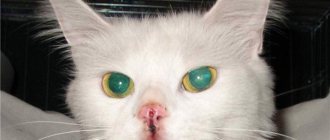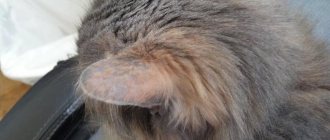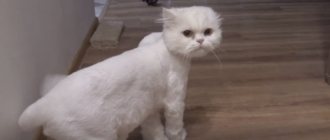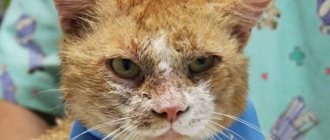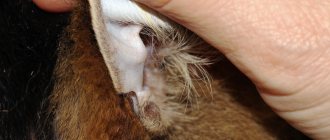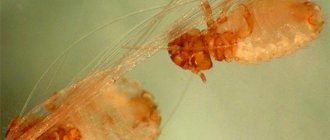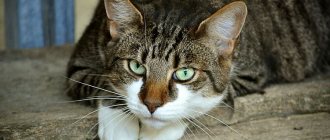Why does a cat go bald: reasons
Baldness (alopecia) leads to the appearance of bare patches of skin on your pet's body.
If there is too much hair, bald spots appear, the animal behaves restlessly
The main reasons for the development of pathology:
- allergic reaction;
- damage by fleas, lice;
- the presence of a scabies parasite;
- otodectosis (ear mites);
- fungal or lichen infections (dermatomycosis, dermatophytosis);
- pyoderma;
- purulent formations on the skin;
- oily seborrhea;
- deficiency or excess of thyroid hormones;
- increased work of the adrenal glands;
- diabetes;
- genetic predisposition;
- stress;
- lack of vitamins;
- chronic diseases of internal organs.
Important! A common cause of alopecia is food allergies. It is not recommended to give pets food from the human table. Veterinarians advise buying specialized food that contains the necessary vitamins and minerals.
Types of alopecia
In veterinary medicine and medicine, the term “alopecia” is used, which means pathological thinning or complete loss of hair in a certain area of a cat’s body.
There are 2 forms of the disease, which can be classified according to the location of the bald patches:
- Diffuse or generalized alopecia is profuse hair loss throughout the body, which leads to significant thinning of the hairline.
- Zonal (focal) alopecia - when hair comes out on a certain area of the body (head, paw, neck, tail).
Alopecia can also be:
- self-induced (self-induced);
- spontaneous (against the background of calcium, zinc and iron deficiency in the cat’s body);
- parasitic (fleas, subcutaneous mites);
- genetic;
- post-traumatic, postoperative.
Self-induced (self-induced)
This type of alopecia is quite common among decorative cat breeds living in apartments. Out of boredom, stress, or for other reasons, the cat begins to lick itself frequently, stopping at certain areas of the body. As a result, the fur becomes thinner and falls out, and constant exposure to the cat's rough tongue prevents the growth of new undercoat. From the outside it looks like a hairless pink spot without injuries or sores. It takes a long time to deal with the problem.
The best and proven methods:
- Purchase a cat diffuser or spray to diffuse pheromones or essential oils. For example, Feliway (pheromones stabilize the cat’s emotional background and reduce unusual forms of stressful behavior) or Relaxivet (lavender, rosemary and geranium oils relieve nervous tension and anxiety).
- Eliminate the cause of stress (get a second cat, fish, buy new toys, a scratching post house, build loopholes or tunnels for exciting leisure time for kittens in the absence of their owners). This will distract your pet from its excessive hygiene.
Sometimes a cat independently licks one area of the body where it feels pain, itching, or burning. This usually occurs after injections into the withers, vaccinations, when applying bandages or the formation of a tumor.
If the cause of anxiety is eliminated, the animal will calm down. You can resort to using a protective collar, which is sold at a pet store.
Independent (spontaneous)
This type of baldness in cats is the most unpredictable and mysterious, because it appears spontaneously and for no particular reason. The fur falls out and does not grow back. Diagnosis is carried out with the participation of a veterinarian in the clinic, who will clarify the following information from the animal owner:
- What is the diet and have there been any changes in the cat’s diet recently? A sudden change in food can cause thinning of the coat (especially if there is food intolerance or the new food is of poorer quality).
- What medications does your pet take and what is it being treated for? Taking some medications can cause your cat's fur to fall out in clumps. Once treatment is complete, the hair will grow back.
- Have you had contact with other animals? This may be the cause of the development of parasitic diseases on the skin.
- What operations did the cat undergo? There may be no fur at the suture site for a long time.
- Whether there were matings, births (lactation period and kittens) and when.
- Did the cat fall from a height or receive other injuries (strong impacts provoke irreversible processes on the skin).
Important! Only after a complete history has been collected and a series of laboratory tests have been carried out, will the veterinarian be able to determine the cause of the disease and diagnose the cat.
Symptoms of hair loss in cats
A healthy cat should have soft and silky fur.
Partial alopecia on the back of a cat
Severe hair loss requires treatment. Alopecia usually begins to manifest itself with the appearance of bald spots on a cat in one area of the body, and other areas of baldness gradually appear.
The skin at the site of loss may be rough and red with small wounds. If the area of a cat’s bald spot is painful or itchy, the animal reacts aggressively to touch.
Lichen
Ringworm is a fungal disease that is also dangerous for humans. First of all, it affects weakened and sick animals, and is very common in street cats. With lichen, the head, neck and limbs go bald. Scabs form on bald areas of the skin. If the animal is not treated, lichen can affect the entire body. At the same time, the cat does not itch, and therefore it is possible to notice lichen in time only by periodically examining the skin of the animal.
Only a veterinarian can accurately determine lichen by scraping or illuminating the affected area with a special lamp. Even after treatment, the affected areas of skin may remain bald.
Diagnosis of alopecia in different parts of the body
Only a doctor can determine why a cat is going bald. The basis of diagnosis includes medical history, visual examination, and microscopic examination of hair roots.
Be sure to read:
Why does a cat bite and gnaw its tail strongly, sometimes until it bleeds? Should I be worried?
The pet's blood is examined and a scraping is taken from the skin. If a tumor is suspected, an x-ray or ultrasound is performed.
The diagnosis is partially helped by the localization of bald spots on a cat:
- Symmetrical baldness of the abdomen, thighs, sides, and front legs is a characteristic symptom of a skin disease.
- Due to stress, cats tear out hairs in the anus , on the back, paws, stomach, and inner thighs. This happens especially often in the following breeds: Siamese, Abyssinian, Himalayan.
- Hormonal disorders are usually indicated by alopecia on the bridge of the nose , base of the tail, hips, and chest. The skin ceases to be elastic.
- In the case of a lack of thyroid hormones, pet hair is easily pulled out in the pelvic area , on the stomach, chest and neck.
- Cancerous formations provoke bald spots on the stomach, chest, and paws . Oncology can cause complete hair loss.
- Vitamin deficiency is characterized by the appearance of small, round bald patches, which can unite. The skin in places where there is no fur is bright pink.
- Fungal infections are characterized by the appearance of bald spots with scaly, cracked skin.
Scratching a pet's skin is dangerous due to infection and the development of an inflammatory process.
To make it easier for you to determine the cause of your pet's baldness, we have prepared a table. It contains all the main pathologies accompanied by hair loss in a cat:
Fleas and ticks
When infected with skin parasites, the animal initially begins to itch severely and feel anxious. Over time, some areas of his skin may begin to go bald. Fleas can cause not only baldness in a cat, but also anemia. It is not so difficult to remove them: you can wash the cat with a special shampoo, drop medicine on the withers, or treat it with a special product. There is no need to ignore this problem, because flea infestation can lead to very unpleasant consequences.
A cat's ears can go bald if ear mites are in an advanced form. Ear mites cause severe itching. Dark dirt forms inside the ears - these are waste products of mites. To remove ticks, you need to regularly clean the animal's ears using cotton swabs and hydrogen peroxide.
A cat becomes bald at the tail, in the area of the ears and eyes, on the bridge of the nose and paw pads if infected with subcutaneous mites. This tick is also contagious to humans. To get rid of it, drug treatment is necessary.
Ticks cause discomfort to the cat, causing severe itching, but they can also lead to the animal becoming infected with dangerous infections. Some species are also dangerous to humans. To prescribe effective treatment, the animal must be shown to a doctor.
How to treat baldness, what to do, how to help at home?
Therapy for the disease is aimed at eliminating the causes of alopecia:
- For allergies, contact with the allergen is eliminated, the use of anti-allergy drugs, immunostimulants, and diet are effective.
- For parasitic lesions, shampoo, ointment, and spray are prescribed.
- Pyoderma and abscesses are eliminated by excision of the affected skin, antibiotics and antiseptics are used to treat wounds.
- Stressful conditions are corrected by taking sedatives.
- Malfunctions of the thyroid gland are treated with hormonal medications; if a tumor develops, surgery is prescribed.
- Bacterial folliculitis is treated with antibiotics, usually amoxicillin. The pet is washed with medicated shampoo.
- For ringworm, the hair needs to be cut, Ketoconazole, Itraconazole, Griseofulvin are taken orally.
Important! Bald spots in cats caused by hereditary causes cannot be treated.
Alopecia associated with cat breed
Today, hairless cats and half-naked breeds are very popular. These include:
- sphinxes;
- rexes;
- Devon Rex;
- lykoy.
However, when breeding these cats, the following problems arise:
- In sphinxes, individual hairs can appear in the form of twisted thin rods; it is difficult for them to break through the thickness of the skin. As a result, nodules develop that turn into comedones.
- In semi-hairless breeds, the coat may grow and shed unevenly, which is considered normal.
- Likoy cats have no hair on their faces in places - this is a breed standard that must be taken into account.
- In blue and beige rexes, hypotrichosis may occur at a young age due to pigmentation problems (breeding defects).
- The birth of hairless kittens in woolly cat breeds as a result of a spontaneous mutation.
Baldness in cats, how to deal with shedding: advice from a veterinarian
Seasonal shedding is normal. This period is especially noticeable for owners of long-haired pets. Molting can last from 2 weeks to 3 months. Veterinarians advise washing and combing animals more often during this time.
Be sure to read:
Why does a cat constantly scratch its chin: what kind of disease is it?
Effective shampoos against hair loss:
- "Phytoelite" from "Veda";
- SynergyLabs Shed-X Cat;
- Perfect Coat 8 in 1.
It is useful to take vitamin complexes, preferably in liquid form.
Bald spots in cats caused by hereditary causes cannot be treated.
To remove hair from the stomach, it is recommended to give special medications:
- Pet Naturals of Vermont;
- Actipet;
- Vaseline oil, etc.
Ordinary grass can help get rid of lumps; in the summer, it is enough for the animal to go for a walk; in winter, the seeds can be purchased at pet stores and planted yourself.
If shedding is accompanied by specific signs, it is necessary to show the cat to a doctor.
Causes of baldness
If a cat is going bald, it is urgent to find out what the reason is. Alopecia is provoked by non-hazardous factors associated with physiological characteristics and pathological causes. The latter cannot be ignored; complications may cause the cat to die.
Seasonal molt
Periodic baldness in cats is normal. Long-haired breeds become especially noticeably bald. The duration of molting is from half a month to 3 months. During the period of baldness, the owner should bathe and comb the pet more often.
For bathing, use pet shampoos that strengthen the coat. Good ones, " Perfect Coat ". A shedding cat licks itself intensively and swallows the hairs that come out. Give your animal medications to remove hairballs from the digestive tract: Actipet , Pet Naturals of Vermont .
Conditions of detention
Both too little and too much grooming can damage your cat's fur. If the owner ignores the need to bathe and comb the pet, then the dirty coat becomes greasy and becomes tangled. In greasy, tangled skin, metabolism is disrupted, hairs weaken and fall out of the follicles. The cat, trying to comb itself, touches the tangles with its claws, tearing out the fur in shreds.
But excessive economic care is also harmful. With frequent bathing and the use of inappropriate products, the coat loses its oil protection, the hairs become thin and brittle. The optimal frequency of procedures is once every six months; when shedding, once a week. Do not use human hygiene products, buy pet shampoos.
Do not let your pet lie for a long time on a running radiator or on a windowsill in direct sun. Otherwise, the hair follicles will become inflamed and the hair will begin to fall out.
If there are several cats living in the house, make sure that they do not fight. If you walk your pet on a leash, check how tight the harness is. Due to the friction of the harness, the neck and armpits become bald. Inflammation and baldness of the neck can be a consequence of using a flea collar, the chemical composition of which is perceived by the body as an allergen.
Stress
Cats are vulnerable and perceive the slightest negativity painfully. Any circumstance can be a stress factor: from cruel treatment by the owner to the inability to catch a bird through a window glass. Emotional shocks have a negative impact on the condition of the coat. With prolonged exposure to stress, the animal begins to go bald in patches, forming an extensive bald spot.
Sometimes severe and prolonged stress provokes the development of a mental disorder called displaced behavior. The animal cannot influence the situation, get rid of stress, so it transfers the effect onto itself: it goes bald, nervously licks and itches, gnaws off its skin, tears out its fur in shreds. If a cat scratches its body excessively, ulcers and bruises form.
Stress factors that cause cat hair loss:
- isolation within four walls, lack of communication;
- lack of physical activity;
- long separation from the owner;
- lack of entertainment;
- jealousy of a new pet;
- moving to another home, renovation;
- bullying from family members.
What should the owner do if the cat is going bald? Eliminate the negative factor. Give your pet enough attention: walk it, play active games at home, pet it, buy toys. If there are several pets in the house, take equal care of each one. Do not get a cat if you are often away or go on business trips.
You should not buy a cat for a family with a baby. Firstly, the pet will become jealous of the owner. Secondly, a baby can inadvertently injure an animal, break its tail, or strangle it. Explain to an older child that a kitten is not a toy and should not be mocked.
When moving or renovating, give your cat a sedative in consultation with your veterinarian.
Hormonal
With dysfunction of the endocrine organ - thyroid, pancreas - metabolism is disrupted. In most cases, the culprit of endocrine disorders and baldness is the owner who gives the pet hormonal drugs to suppress sexual desire without the consent of the veterinarian.
With endocrine pathologies, different parts of the body itch intensely. The cat itches constantly and intensely, and goes bald. After castration and with pathologies of the ovaries in females and testes in males, the skin under the tail becomes bald.
What hormonal pathologies in cats are accompanied by baldness:
- Hyperthyroidism is an increased function of the thyroid gland. The cat has seborrhea, the fur comes out in clumps from a light touch.
- Cushing's disease - increased synthesis of corticosteroids.
- Diabetes is a disorder of the pancreas. In addition to baldness, the cat has thirst, frequent urination, and an acetone odor from the mouth.
Treatment involves taking hormonal medications, which should be chosen by a veterinarian.
Estrus
For a cat, estrus is a stressful period. Empty ovulation takes away physical strength and depletes the immune system. The fur comes out evenly and the skin temperature rises.
If you do not plan to breed the breed, sterilize the cat. This will save the animal from suffering and baldness. Empty estrus is not only a painful process, but also dangerous: there is a high probability of the appearance of malignant tumors of the gonads.
Pregnancy
The body of a pregnant cat works hard, wasting energy not only on itself, but also on the embryos developing in the womb. Intensive waste of the body's resources inevitably affects the condition of the coat: the hairs become thinner and come out in clumps.
Baldness continues after childbirth, because a significant part of the nutrients leaves the body into milk. The belly of a cat that has given birth goes bald most intensively, which is caused by hormonal changes. The mother's hairless sides and belly help newborn kittens to stay warm, and finding nipples in the absence of hair becomes easier.
A nursing cat needs an increased supply of vitamins and nutrients, so buy high-quality food designed specifically for postpartum animals. When feeding naturally, enrich the diet with vitamin and mineral complexes in consultation with your veterinarian.
Poor nutrition
A common reason why a cat goes bald is food allergies. The owner does not care about the pet’s healthy diet, buys cheap food, gives food that is unsuitable for the cat’s body or is expired, as a result, allergens and toxic substances enter the pet’s body.
Most often, the allergen is cheap, low-quality store-bought food. The quality of nutrition determines not only the health of the coat, but also the general well-being of the cat. The components included in cheap feeds provoke baldness and internal pathologies. Therefore, when purchasing cat food, carefully read the ingredients list.
If the ingredient list simply says “meat,” then the manufacturer hides the ingredients. High-quality food indicates what type of meat was used and in what volume.
You should absolutely not buy food for your cat that contains:
- preservatives;
- synthetic dyes (E127 is especially dangerous - a provocateur of cancer);
- sugar, its derivatives;
- cellulose fibers;
- propylene glycol;
- antioxidant E310 (causes asthmatic attacks);
- antioxidant E324 (strong carcinogen);
- antioxidants BHA and BHT (cause malignant tumors in animals).
To prevent your cat from going bald due to allergies and to remain healthy, do not skimp on nutrition, buy high-quality food from trusted manufacturers that contain a full range of essential vitamins, minerals, and nutrients. Best brands:
- Royal Canin;
- Acana;
- Orijen;
- Brit;
- Hill's;
- Almo Nature;
- Golden Eagle;
- Innova;
- Farmina.
Natural food can also be an allergen for cats. It could be chicken, pork, fish, milk. The symptoms are pronounced: hair comes out evenly on the stomach and paws, the cat is tormented by unbearable itching, the skin is red and covered with a rash. Often, due to allergies, a cat's ears become bald due to inflammation. The pet scratches its ears until blood comes out of the itchy wounds.
Having identified the allergen, exclude the harmful product from the cat's menu. Do not give your pet food from the human table.
Avitaminosis
When the owner does not provide a balanced diet, the pet begins to lose weight, go bald, becomes lethargic, apathetic, anemic, the fur becomes dull - this is the beginning of vitamin deficiency. With a deficiency of vitamins A, C, group B, bare spots appear on the back, limbs and head, gradually merge, and the skin turns red.
It’s time to immediately start normalizing your diet, otherwise your metabolism will worsen and the functioning of your internal organs will be disrupted. Buy a cat vitamin complex for coat health in liquid form. Remember that an excess of vitamins is just as harmful as a deficiency: it provokes toxicosis and impaired liver function. Do not give your cat drugs in high doses, coordinate the appointment with your veterinarian.
Allergy
Allergic dermatitis is a reaction to substances that come into contact with the skin and respiratory tract: medications, household chemicals, pollen, fragrances, flea or tick medications. An allergic reaction is manifested by baldness, itching, redness of the skin, and a pustular rash. The cat constantly scratches the itchy areas, causing fur to come out.
How to treat dermatitis - antihistamines, immunostimulants. The main condition for recovery is the elimination of the allergen.
Adenitis
Disruption of the sebaceous glands is manifested by baldness, inflammation of the skin, and the formation of scales, first dry, then wet and sticky. The cat's ears and head are going bald. Spots without fur covering the ear, back of the head, eyebrow, rounded, exude a stench. In advanced cases, balding areas appear on the tail and along the spine. The spots itch, the animal constantly licks and itches.
Fleas
A cat affected by fleas becomes nervous, goes bald, sleeps poorly, scratches, and licks the bite site. The saliva of parasites is an allergen and causes inflammation, bald spots, and dandruff. Not only stray cats are affected by fleas; a pet can pick up the parasite from an owner who comes in from the street.
Flea-infested cats are treated with special pet shampoos and sprays.
Mite
Parasitic mites cause the following pathologies:
- Demodicosis is a skin lesion with itchy patches of baldness.
- Cheyletiellosis is an infection of the skin with intense itching, peeling, and hair loss.
- Otodecosis is infection of the ears by mites. The affected ear itches, the cat scratches his temple. It can tear your ears until they bleed, and a bald spot will appear on your temples.
- Scabies is a lesion of the upper layer of skin with baldness and unbearable itching. The tick prefers areas with thin skin: above the eyebrows, between the toes, nose, jaw.
Lichen
Cats with weak immune systems are susceptible to fungal disease. The skin on the face and above the eyes is the first to go bald. Bald areas turn red, peel, itch, and expand. Purulent foci appear.
Ringworm is a contagious disease; treatment should not be delayed. Medicines are prescribed by a veterinarian; incorrect independent actions can make baldness chronic.
The drugs Itraconazole and Ketoconazole are usually used for treatment.
lice eaters
Parasites damage the fur. The fur breaks off and comes out. Baldness is aggravated by constant itching, due to which the cat begins to intensively scratch its body.
Oncology
The body fighting cancer cells does not provide the hair follicles with sufficient nutrition. Therefore, the cat's fur grows intensely.
Ignoring cancer is dangerous and there is a high probability of the animal’s death. The owner must monitor the well-being of the pet. If the cat has suddenly lost weight, is not eating, is going bald, the lymph nodes are swollen, ulcers and purulent wounds appear on the outside, contact your veterinarian immediately.
The tumor is removed by a surgeon, followed by chemotherapy. Don't worry if your cat is going bald on the belly, spine and hind legs: this is a reaction to the medications. After chemotherapy, the fur will recover.
Infection
Infectious diseases deplete the immune system, so a recovering cat may go bald. Usually the cat's face and stomach become bald.
Baldness can be caused by pyoderma, a purulent inflammation of the skin, and folliculitis, a bacterial inflammation of the hair follicles. Antibiotics are used for treatment.
Age
When 5-month-old kittens go bald, we are talking about juvenile molting. Within 3 months, a kitten's baby fur is replaced by adult fur.
Bald spots on the fur are a sign of the onset of old age. In older cats, the stomach does not properly digest food, and the body receives little nutrition. An older cat may frequently lick the part of the body where the joints are affected. Usually this is the leg. In areas that are licked, the fur wears off.
Disorders of internal organs
Alopecia in cats is provoked by various diseases of the digestive tract, accompanied by nausea, defecation disorders, loss of appetite, weight loss:
- pancreatitis - inflammation of the pancreas;
- cirrhosis – destruction of liver cells;
- gastritis , colitis, other disorders of the stomach and intestines.
When a cat has digestive diseases, the first thing to go bald is the tail. The listed pathologies often arise if the owner feeds the cat spoiled food, allows obesity, or does not give vitamins.
Preventing hair loss in cats
To protect your pet from the unpleasant symptoms of hair loss, owners need to follow several rules:
- Provide your cat with a balanced diet.
- Avoid factors that provoke stress.
- Vaccinate against infectious diseases on time.
- Avoid contact between a healthy animal and a sick one.
- Treat wool promptly when parasites appear.
- Carry out preventive examinations regularly.
Hypotrichosis
This is a hereditary pathology of kittens, which looks like a hair anomaly - loss of hair (complete or partial), and then growth of it again. Kittens may be born without hair, whiskers, claws, or tongue papillae.
Adult cats often have a complete absence of hair in some areas of the body or the appearance of fluff. A detailed examination of bald spots can reveal altered hair follicles or their complete absence.
Hypotrichosis is not a disease, but a genetic disorder that cannot be treated. It is recommended to castrate animals with this developmental feature.
Breeds prone to this pathology in genotype:
- Burmese (or sacred Burma);
- Burmese (or Burmese);
- Devon Rex;
- Siamese
The cat began to lose hair on his neck and behind his ears.
Daughter Sophia (07/11/08) and son Danilka (03/09/11) :)))
02.25.10 13:41 Reply to the message The cat began to lose hair on its neck and behind the ears by Tella222
Appearance is an eternal letter of recommendation
02.25.10 14:41 Reply to the message The cat began to lose hair on its neck and behind the ears by Tella222
Freedom for Angela Davis!
02.25.10 16:58 Reply to the message The cat began to lose hair on its neck and behind the ears by Tella222
The main difference between animals and people is that animals do not keep people in their homes. Although cats may not agree with me.
02/25/10 18:06 Reply to the message The cat began to lose hair on its neck and behind the ears by Tella222
Corrected by Merigold (25.02.10 18:11)
02/27/10 12:55 Reply to the message The cat began to lose hair on its neck and behind the ears by Tella222
Corrected by user Ryzhinka (27.02.10 13:17)
02/27/10 23:31 Reply to message Re: The cat began to lose hair on its neck and behind the ears of user dm666
Daughter Sophia (07/11/08) and son Danilka (03/09/11) :)))
02/27/10 23:35 Reply to message Re: The cat began to lose hair on its neck and behind the ears by user Tattunhamon
In response to: Sorry, I didn’t quite understand. The cat’s entire neck is bald, it’s starting to fall out behind the ears, but you haven’t been to the doctors yet and have started a problem? What to do. Run to the doctor.
Daughter Sophia (07/11/08) and son Danilka (03/09/11) :)))
02.28.10 13:30 Reply to message Re: The cat began to lose hair on its neck and behind the ears by user Tella222
El saber no ocupa lugar
02.28.10 13:54 Reply to message Re: The cat began to lose hair on its neck and behind the ears by user Tella222
Well, I dropped everything and ran. The cat is really scary to look at, but the child is more precious to me, and my husband doesn’t care about the cat.
It's amazing how you treat an animal, which is completely up to you! Why did you even get a live cat? Are you too lazy to pick it up? That’s right, the cat is not a child, he won’t say that he’s bothering him and he won’t tell on his mother to the neighbors.. They dragged the husband in for some reason.. And the baby seems to spend 24 hours a day at your breast continuously, since you can’t “throw away”
The cat itches until it hurts and the hair falls out: How to treat it at home?
Every owner should understand that many drugs that can be used by humans and other animals cannot be used on cats.
For example, skin lesions are often treated with Yam BK ointment. This is strictly forbidden, since the tar contained in this drug is toxic to cats.
Like this article? Read other materials about cats on our website: How to give medicine to a cat? Tips for ensuring comfort for a cat - https://strazhchistoty.ru/cleanup/cleancats/kak-dat-lekarstvo-koshke.html How to learn to understand your cat (Practical tips) - https://strazhchistoty.ru/cleanup/cleancats/kak -ponimat-koshku.html
How can you help yourself without causing harm?
Try to limit access to the body area if the cat injures itself. A protective collar or blanket can help with this.
Trim your cat's claws or apply safe anti-scratch pads.
Itching can be controlled using a suspension or spray with the same name Stop Itching . It is important to understand that you will only remove the symptom, and after a course of the drug the problem may return.
The crusts can be soaked and removed using saline or Chlorhexedine.
Also, if there has been no treatment for fleas and ticks for a long time (the apple tree is a month old), it is worth doing it. Suitable drugs: Stronghold, Lawyer, Helmintal, Inspector, Bravecto.
And, of course, we recommend taking your pet to see a doctor as soon as possible.
Prevention of itching: does it exist at all, and what can be done?
Itching is caused by various factors, so following a number of prevention rules will help protect your cat from scratching:
- Poison worms in a timely manner. This will also help protect children who constantly play with animals. You should not give your cat raw foods: fish, meat.
- After each walk, inspect the animal for abrasions. Treat detected wounds with iodine or other disinfectants.
- To avoid infection with parasites, the cat should not be allowed to come into contact with other animals.
- Disinfect the cat litter box regularly.
- The transition to a new food should be carried out gradually.
- Do not punish your cat for minor offenses: this will prevent stress.
What measures are needed to prevent the problem?
The problem has been identified, the cat is scratching its neck and hair is coming out. And the bald patches all over the baby’s body say that you can’t cope with the problem on your own. What to do? The best thing to do is go to a veterinary clinic. An accurate diagnosis is needed. Tests and monitoring of the cat’s general condition will help you find out exactly what is causing hair loss from the kitten’s neck.
You may have to change the food or cleanse your pets of parasites. Only a doctor can decide whether vitamins or medications are needed to treat your cat.
